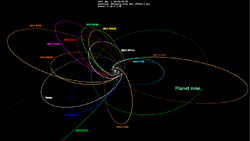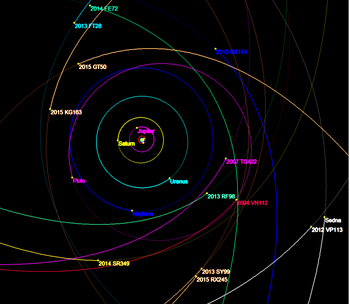Astronomy:2015 KG163
 The orbit of 2015 KG163 (right side, in orange) and other extreme detached objects, along with the hypothetical Planet Nine's orbit on the right | |
| Discovery[1] | |
|---|---|
| Discovered by | OSSOS |
| Discovery site | Mauna Kea Obs. |
| Discovery date | 24 May 2015 |
| Designations | |
| 2015 KG163 | |
| o5m52[2] | |
| Minor planet category | TNO[3] · detached[4] · distant[5] |
| Orbital characteristics[7] | |
| Epoch 25 February 2023 (JD 2460000.5) | |
| Uncertainty parameter 3[3] | |
| Observation arc | 2.02 yr (739 days) |
| Earliest precovery date | 17 May 2015 |
| |{{{apsis}}}|helion}} | 1319 astronomical unit|AU |
| |{{{apsis}}}|helion}} | 40.493 AU |
| 679.816 AU | |
| Eccentricity | 0.94043 |
| Orbital period | 17713 yr |
| Mean anomaly | 0.014° |
| Mean motion | 0° 0m 0.2s / day |
| Inclination | 13.994° |
| Longitude of ascending node | 219.103° |
| |{{{apsis}}}|helion}} | ≈ 10 August 2022[6] ±2 months[lower-alpha 1] |
| 32.097° | |
| Physical characteristics | |
| Mean diameter | 65–150 km (est. 0.04–0.20)[8] |
| Apparent magnitude | 24.2 (discovery)[1] |
| Absolute magnitude (H) | 8.2[3][5] |
2015 KG163, also known as o5m52, is a trans-Neptunian object from the outermost region of the Solar System, approximately 102 kilometers (63 miles) in diameter. It was first observed on 24 May 2015, by astronomers of the Outer Solar System Origins Survey using the Canada–France–Hawaii Telescope at Mauna Kea Observatories, Hawaii, United States.[5] With an observation arc of 2 years, it passed perihelion around August 2022[6][lower-alpha 1] at a velocity of 6.5 km/s with respect to the Sun.
It is one a small number of detached objects with perihelion distances of 30 AU or more, and semi-major axes of 250 AU or more.[9] Such objects can not reach such orbits without some perturbing object, which lead to the speculation of Planet Nine. Its argument of perihelion is similar to that of 2013 FT28, but its semi-major axis is larger, such that its orbit may cross that of Plant Nine.
Notes
References
- ↑ 1.0 1.1 "MPEC-2017-M23 : 2015 KG163". Minor Planet Electronic Circular. Minor Planet Center. 19 June 2017. https://minorplanetcenter.net/mpec/K17/K17M23.html. Retrieved 5 July 2023.
- ↑ Shankman, Cory (2017). "OSSOS. VI. Striking Biases in the Detection of Large Semimajor Axis Trans-Neptunian Objects". The Astronomical Journal 154 (2): 50. doi:10.3847/1538-3881/aa7aed. Bibcode: 2017AJ....154...50S. https://pure.qub.ac.uk/portal/en/publications/ossos-vi-striking-biases-in-the-detection-of-large-semimajor-axis-transneptunian-objects(027b7a9c-a171-42b4-9449-9355b0a255d4).html.
- ↑ 3.0 3.1 3.2 3.3 "JPL Small-Body Database Browser: (2015 KG163)". Jet Propulsion Laboratory. https://ssd.jpl.nasa.gov/tools/sbdb_lookup.html#/?sstr=2015%20KG163. Retrieved 4 August 2022.
- ↑ "List of known trans-Neptunian objects". Johnstonsarchive.net. 5 September 2016. http://www.johnstonsarchive.net/astro/tnoslist.html. Retrieved 1 November 2017.
- ↑ 5.0 5.1 5.2 "2015 KG163". Minor Planet Center. http://www.minorplanetcenter.net/db_search/show_object?object_id=2015+KG163. Retrieved 1 November 2017.
- ↑ 6.0 6.1 JPL Horizons Observer Location: @sun (perihelion occurs when deldot changes from negative to positive)
- ↑ "JPL Horizons On-Line Ephemeris for 2015 KG163 at epoch JD 2460000.5". JPL Horizons On-Line Ephemeris System. Jet Propulsion Laboratory. https://ssd.jpl.nasa.gov/horizons_batch.cgi?batch=1&COMMAND='2015+KG163'&TABLE_TYPE='ELEMENTS'&START_TIME='JD2460000.5'&STOP_TIME='JD2460200.5'&STEP_SIZE='1y'&CENTER='@0'&OUT_UNITS='AU-D'. Retrieved 5 July 2023. Solution using the Solar System Barycenter. Ephemeris Type: Elements and Center: @0)
- ↑ "Asteroid Size Estimator". Center for Near Earth Object Studies. Jet Propulsion Laboratory. https://cneos.jpl.nasa.gov/tools/ast_size_est.html. Retrieved 5 July 2023.
- ↑ "MPC-query: a>250 and q<30". Minor Planet Center. http://minorplanetcenter.net/db_search/show_by_properties?perihelion_distance_min=30&semimajor_axis_min=250. Retrieved 1 November 2017.
External links
- 2015 KG163 at AstDyS-2, Asteroids—Dynamic Site
- 2015 KG163 at the JPL Small-Body Database
 |


